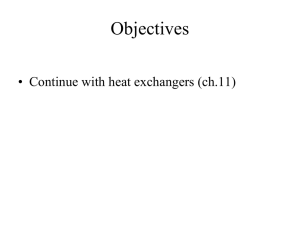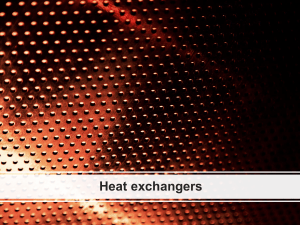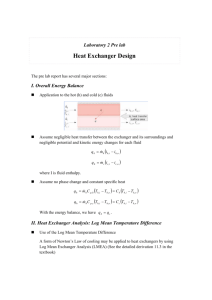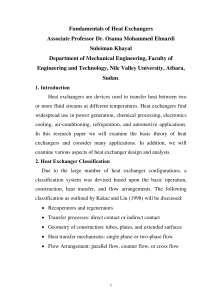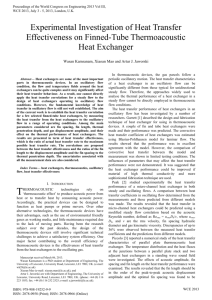Basic Equations for Heat Exchanger Design
advertisement
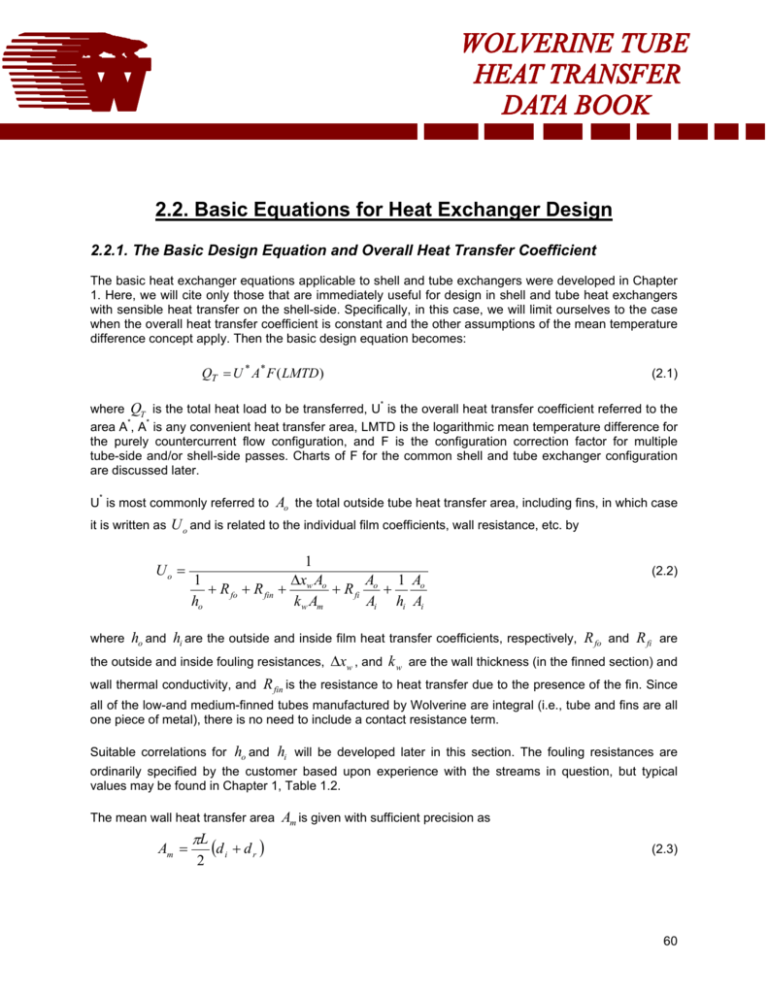
2.2. Basic Equations for Heat Exchanger Design 2.2.1. The Basic Design Equation and Overall Heat Transfer Coefficient The basic heat exchanger equations applicable to shell and tube exchangers were developed in Chapter 1. Here, we will cite only those that are immediately useful for design in shell and tube heat exchangers with sensible heat transfer on the shell-side. Specifically, in this case, we will limit ourselves to the case when the overall heat transfer coefficient is constant and the other assumptions of the mean temperature difference concept apply. Then the basic design equation becomes: QT = U * A* F ( LMTD ) (2.1) where QT is the total heat load to be transferred, U* is the overall heat transfer coefficient referred to the area A*, A* is any convenient heat transfer area, LMTD is the logarithmic mean temperature difference for the purely countercurrent flow configuration, and F is the configuration correction factor for multiple tube-side and/or shell-side passes. Charts of F for the common shell and tube exchanger configuration are discussed later. U* is most commonly referred to Ao the total outside tube heat transfer area, including fins, in which case it is written as U o and is related to the individual film coefficients, wall resistance, etc. by Uo = 1 A 1 Δx A 1 Ao + R fo + R fin + w o + R fi o + Ai hi Ai k w Am ho (2.2) where ho and hi are the outside and inside film heat transfer coefficients, respectively, R fo and R fi are the outside and inside fouling resistances, Δxw , and k w are the wall thickness (in the finned section) and wall thermal conductivity, and R fin is the resistance to heat transfer due to the presence of the fin. Since all of the low-and medium-finned tubes manufactured by Wolverine are integral (i.e., tube and fins are all one piece of metal), there is no need to include a contact resistance term. Suitable correlations for ho and hi will be developed later in this section. The fouling resistances are ordinarily specified by the customer based upon experience with the streams in question, but typical values may be found in Chapter 1, Table 1.2. The mean wall heat transfer area Am is given with sufficient precision as Am = πL 2 (d i + d r ) (2.3) 60 If it is preferred to use an overall heat transfer coefficient based upon the inside heat transfer area Ai the following relationship holds: U o Ao = U i Ai (2.4) It is of the greatest importance to always identify the reference area when quoting the value of a film or overall heat transfer coefficient. 2.2.2. Fin Efficiency and Fin Resistance The general concept of fin efficiency and fin resistance was developed in Chapter 1. Accordingly, we will only reiterate the major equations and concepts here. The value of R fin for use in Eq (2.2) is given by R fin ⎡ ⎤ ⎢ 1 − Φ ⎥⎡ 1 ⎤ ⎥ ⎢ + R fo ⎥ =⎢ ⎢ Aroot + Φ ⎥ ⎣ ho ⎦ ⎢ Afin ⎥ ⎣ ⎦ (2.5) where Φ is the fin efficiency and is given by: Φ= 1 (2.6) 2 m 1+ 3 do / dr where m=H 2 ⎛1 ⎞ ⎜⎜ + R fo ⎟⎟k wY ⎝ ho ⎠ (2.7) Also, ⎛ s ⎞ Aroot = πd r L⎜ ⎟ = πd r L N f s ⎝s +Y ⎠ (2.8) and A fin = 2 (d 4 π 2 o ) − d r LN f 2 (2.9) Typical fin efficiencies for S/T Trufin are above 0.90 for virtually all applications, often approaching 1.00 for those applications in which low-finned Trufin is most valuable. 61 These are shown in Chapter I as a function of 1 + R fo for the various metals out of which S/T Trufin is ho manufactured. Use of these figures (1.51 and 1.52) shortcuts the need to carry out the calculation of Eqns. (2.5 to 2.9) for most design cases. 2.2.3. Mean Temperature Difference, F Factors We will use the Mean Temperature Difference (MTD) formulation for design of heat exchangers in this Manual. The MTD is related to the Logarithmic Mean Temperature Difference (LMTD) by the equation MTD=F(LMTD) (2.10) where the LMTD is always defined as for the countercurrent flow arrangement shown in Fig. 2.4: LMTD = (T1 − t 2 ) − (T2 − t1 ) ⎛T − t ⎞ ln⎜⎜ 1 2 ⎟⎟ ⎝ T2 − t1 ⎠ (2.11) In the rare occasion that the heat exchanger is a purely cocurrent (parallel) flow arrangement, F = I and the LMTD is given by LMTD = (T1 − t1 ) − (T2 − t2 ) ⎛ T −t ⎞ ln⎜⎜ 1 1 ⎟⎟ ⎝ T2 − t2 ⎠ (2.12) where T1 and t1 are the shellside and tubeside inlet temperatures, respectively, and T2 and t2 are the corresponding outlet temperatures. The value of F depends upon the exact arrangement of the streams within the exchangers, the number of ex changers in series, and two parameters defined in terms of the terminal temperatures of the two streams: R= T1 − T2 Range of shell fluid = t 2 − t1 Range of tube fluid t −t Range of tube fluid P= 2 1 = T1 − t1 Maximum temperatur e difference (2.13) (2.14) The mathematical relationships between F, R, and P have been reported in a number of places, e.g., Refs. (1, 2), but the graphical representations are of the greatest interest to us in this Manual. These are shown for the most important cases in Figs. 2.5 to 2.12, inclusive. 62 Once the terminal temperatures of both streams of a heat exchanger are specified or otherwise determined, R, P, and LMTD can be calculated, F found for the heat exchanger configuration, and finally the MTD can be calculated. Values of F below 0.8 or 0.75 at the lowest should not be used for three reasons: 1. The charts cannot be read accurately. 2. The low value of F means that substantial additional area must be supplied in the heat exchanger to overcome the inefficient thermal profile. 3. Design in or near the steep portion of the curves indicates that the thermodynamically limiting configuration is being approached, even if all the assumptions are perfectly satisfied. Violation of even one of the assumptions (e.g., excessive bypassing) by even a little bit may result in an exchanger that is in fact thermodynamically incapable of meeting the specified temperatures. If the value of F determined for the proposed configuration is too low, the use of additional shells in series will result in an improvement, as shown by the successive F charts for given values of R and P. Alternatively, it may be possible to redesign the exchangers to permit the use of fixed tube sheet units and purely countercurrent flow (for which F is unity.) 63 64 65 66 67 68 69 70 71




